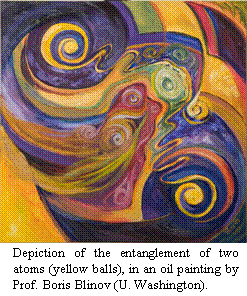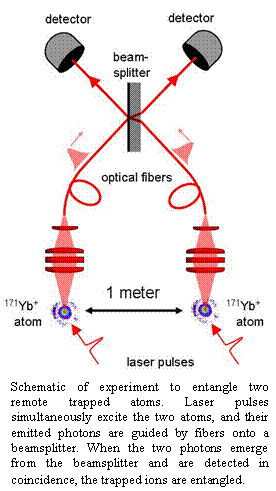“Spooky action-at-a-distance” with individual atoms |
||||
Albert Einstein never liked Quantum Mechanics, with its fuzzy superpositions and confused states of reality. In 1935, he and colleagues Boris Podolsky and Nathan Rosen proposed a thought experiment that they believed would finally show cracks in the new quantum theory. The essentials of their famed proposal can be seen by cconsidering two “quantum coins,” that are prepared in a strange superposition of being both heads-up and both tails-up at the same time. When such coins are brought far apart from each other and then measured, quantum mechanics predicts that the only possible results can be HH and TT – the orientation of the coins always matches in perfect correlation. But when either individual coin is observed, its value is expected to be totally random (H or T). What’s interesting here is that while an individual coin is in an indeterminate state until observed, the observer immediately knows that orientation of the other coin, and this knowledge happens faster than the speed of light can traverse the distance between the coins.
Einstein called this quantum behavior “spooky action-at-a-distance,” and concluded that either quantum mechanics is incomplete, or it is just very weird. We now know, thanks to John Bell in 1964, that if quantum mechanics is indeed incomplete, than any more complete theory must be just as weird, so we might as well stick with quantum mechanics. Bell devised a measure of this weirdness: an inequality involving measured pair-correlations that is violated for situations like the one considered by Einstein, Podolsky and Rosen. This weird type of quantum state the Einstein introduced is now known as an “entangled state,” and the spooky action-at-a-distance that he bemoaned is now the central resource in the field of Quantum Information Science. Replace the coins by quantum bits that can be in the state 0 and 1 simultaneously, and these qubits can be used for superfast computing applications, or fundamentally secure communication. Qubits are now being investigated in a variety of physical systems, from individual atoms and photons, to superconducting circuits and semiconductor quantum dots.
Recently, a team of researchers from the University of Maryland Department of Physics and Joint Quantum Institute have observed for the first time, quantum entanglement of individual atoms separated by a large distance [Moehring, et al., Nature 449, 68, (2007)]. Two atoms, held in electromagnetic traps one meter apart, were synchronized with a laser pulse, and the resulting emitted light was interfered on a beamsplitter and detected. This detection produced an entangled state of the two atoms, where qubits were stored in the magnetic orientation of each atom. This entanglement (the correlations of the atomic-scale magnets and the randomness of each one individually) was directly verified by measuring the magnetic orientation with a separate laser, resulting in a clear violation of Bell inequalities. This type of quantum linking between atomic qubits may ultimately lead to the fabrication of a large-scale quantum computer, where atomic memories will be able to store exponentially-rich amounts of data and be connected through optical interconnects as demonstrated here. In the nearer term, this is among the most promising roads to a “quantum repeater,” where qubits can be propagated over very large (or even geographic) distances with the use of optical fibers.
-------------------------------------------------------------------------------------------------------------------------------------------------------------------------------------------- |



